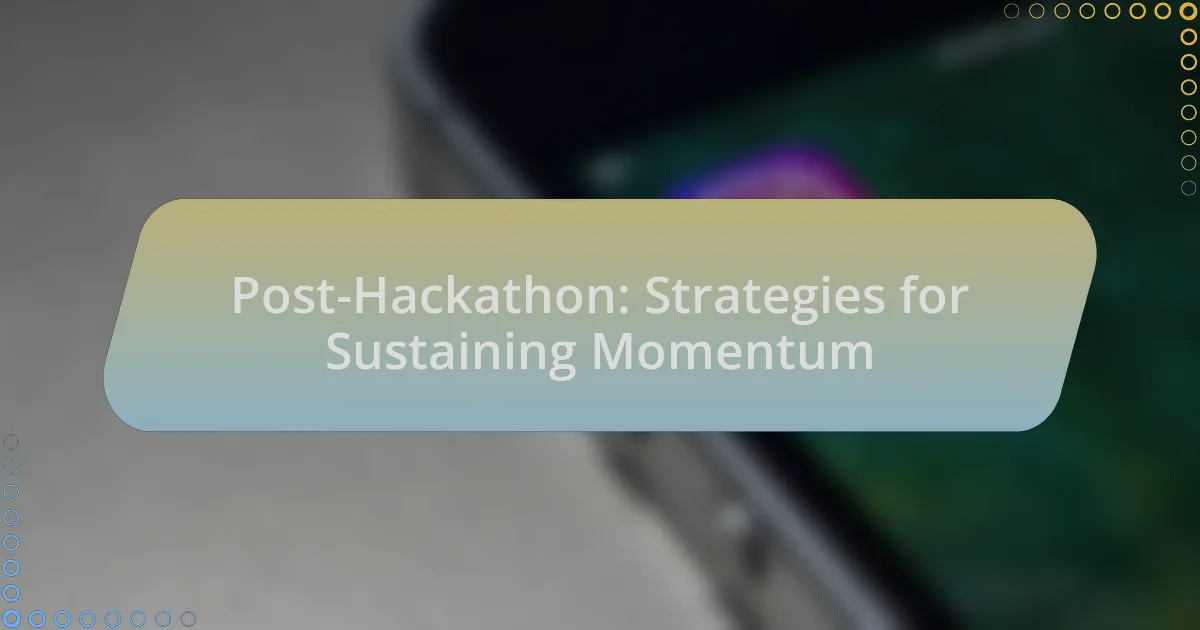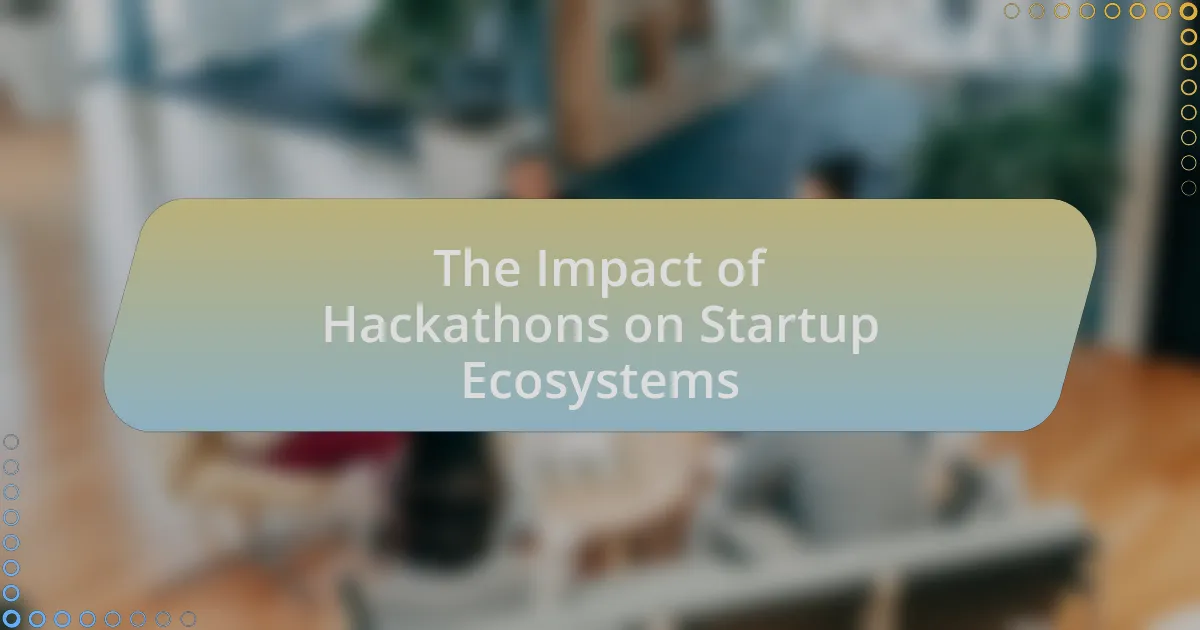A Sustainable Hackathon Model is an event framework aimed at reducing environmental impact while enhancing social and economic benefits. This model emphasizes long-term sustainability through practices such as digital participation, sustainable sourcing, and community engagement. Key characteristics include inclusivity, resource efficiency, and a focus on addressing social and environmental challenges. The article outlines the differences between sustainable and traditional hackathons, the importance of sustainability in planning, and strategies for integrating eco-friendly practices. It also discusses challenges organizers face, the role of partnerships and sponsors, and best practices for creating an effective sustainable hackathon.

What is a Sustainable Hackathon Model?
A Sustainable Hackathon Model is an event framework designed to minimize environmental impact while maximizing social and economic benefits. This model incorporates practices such as digital participation to reduce travel emissions, sustainable sourcing of materials, and a focus on projects that address social and environmental challenges. Research indicates that events adopting sustainable practices can significantly lower their carbon footprint, with studies showing that virtual or hybrid formats can reduce travel-related emissions by up to 80%.
How does a sustainable hackathon model differ from traditional models?
A sustainable hackathon model differs from traditional models primarily in its focus on long-term impact and environmental responsibility. While traditional hackathons often prioritize rapid development and immediate outcomes, sustainable models integrate considerations for social, economic, and environmental sustainability throughout the event. For instance, sustainable hackathons may implement practices such as minimizing waste, promoting diversity and inclusion, and fostering ongoing community engagement, which contrasts with the more short-term, competitive nature of traditional formats. Research indicates that events designed with sustainability in mind can lead to more innovative solutions that address pressing global challenges, as seen in initiatives like the Global Hackathon for Climate Action, which emphasizes eco-friendly practices and community involvement.
What are the key characteristics of a sustainable hackathon model?
A sustainable hackathon model is characterized by inclusivity, long-term impact, and resource efficiency. Inclusivity ensures diverse participation, fostering innovation through varied perspectives, which is supported by research indicating that diverse teams outperform homogeneous ones in problem-solving. Long-term impact focuses on creating solutions that address real-world challenges, with follow-up support for projects post-hackathon, as evidenced by successful initiatives that have led to ongoing development and implementation of ideas. Resource efficiency involves minimizing waste and optimizing the use of materials and technology, aligning with sustainability principles that advocate for responsible consumption and environmental stewardship.
Why is sustainability important in hackathon planning?
Sustainability is important in hackathon planning because it ensures that the event minimizes its environmental impact while promoting social responsibility. By integrating sustainable practices, such as reducing waste, utilizing eco-friendly materials, and encouraging digital solutions, hackathons can foster innovation that aligns with global sustainability goals. For instance, a study by the United Nations indicates that events adopting sustainable practices can significantly reduce carbon footprints, thereby contributing to climate action. This approach not only enhances the reputation of the hackathon but also inspires participants to consider sustainability in their projects, ultimately leading to more impactful and responsible technological advancements.
What are the core principles of sustainability in hackathons?
The core principles of sustainability in hackathons include environmental responsibility, social equity, and economic viability. Environmental responsibility focuses on minimizing waste and promoting eco-friendly practices, such as using digital resources instead of paper and encouraging participants to use sustainable transportation. Social equity emphasizes inclusivity, ensuring diverse participation and accessibility for all individuals, regardless of background. Economic viability involves creating a sustainable financial model that supports the event’s longevity, such as securing sponsorships and partnerships that align with sustainability goals. These principles collectively foster a holistic approach to organizing hackathons that contribute positively to society and the environment.
How can environmental considerations be integrated into hackathons?
Environmental considerations can be integrated into hackathons by implementing sustainable practices throughout the event. Organizers can prioritize digital solutions over physical materials, such as using online platforms for submissions and communication to reduce paper waste. Additionally, they can encourage participants to develop projects focused on environmental issues, such as climate change or resource conservation, thereby aligning the hackathon’s goals with sustainability.
Moreover, providing locally sourced, plant-based catering options can minimize the carbon footprint associated with food. According to a study by the Food and Agriculture Organization, plant-based diets can significantly reduce greenhouse gas emissions. Finally, promoting recycling and waste management during the event can further enhance environmental responsibility, as evidenced by initiatives that have successfully reduced waste in similar events by up to 50%.
What social impacts should be considered in a sustainable hackathon?
Social impacts to consider in a sustainable hackathon include community engagement, diversity and inclusion, and the potential for social innovation. Community engagement ensures that local needs and perspectives are addressed, fostering a sense of ownership and collaboration among participants. Diversity and inclusion promote varied viewpoints, which can lead to more innovative solutions and equitable outcomes. Additionally, the potential for social innovation arises when hackathon projects focus on solving pressing social issues, such as poverty, education, and health disparities, thereby contributing positively to society. These factors collectively enhance the hackathon’s relevance and effectiveness in creating sustainable solutions.
What challenges do organizers face in creating a sustainable hackathon model?
Organizers face several challenges in creating a sustainable hackathon model, primarily including funding, participant engagement, and resource allocation. Securing consistent financial support is difficult, as many sponsors may only commit to one-time events rather than long-term partnerships. Additionally, maintaining participant interest over multiple events requires innovative themes and continuous community engagement, which can be resource-intensive. Furthermore, effectively managing logistics, such as venue selection and technology provision, poses a challenge, as these factors directly impact the overall experience and sustainability of the hackathon model.
How can budget constraints affect sustainability efforts?
Budget constraints can significantly hinder sustainability efforts by limiting the resources available for implementing eco-friendly practices. When organizations face financial limitations, they may prioritize short-term cost savings over long-term sustainable investments, such as renewable energy systems or waste reduction programs. For instance, a study by the World Resources Institute found that companies with tighter budgets often opt for cheaper, less sustainable materials, which can lead to increased environmental degradation. Additionally, budget constraints can restrict the ability to hire experts or invest in innovative technologies that promote sustainability, ultimately undermining the effectiveness of sustainability initiatives.
What logistical issues arise when implementing sustainable practices?
Implementing sustainable practices often leads to logistical issues such as supply chain disruptions, increased costs, and resource allocation challenges. Supply chain disruptions occur because sourcing sustainable materials may require new suppliers or longer lead times, impacting project timelines. Increased costs arise from the potential premium on sustainable materials and technologies, which can strain budgets. Resource allocation challenges manifest when organizations must balance sustainability goals with existing operational processes, often requiring additional training and adjustments in workflow. These logistical issues can hinder the effective implementation of sustainable practices in various contexts, including hackathons.
How can partnerships enhance the sustainability of hackathons?
Partnerships can enhance the sustainability of hackathons by providing essential resources, expertise, and ongoing support. Collaborating with organizations, sponsors, and educational institutions allows hackathons to access funding, mentorship, and technology, which can significantly reduce costs and improve the quality of the event. For instance, partnerships with local businesses can lead to in-kind donations such as venue space, catering, or equipment, which lowers financial barriers. Additionally, engaging with universities can foster a continuous pipeline of talent and innovation, as students gain practical experience while contributing to real-world projects. Research indicates that events with strong partnerships tend to have higher participant satisfaction and retention rates, ultimately leading to more successful and sustainable outcomes.
What role do sponsors play in a sustainable hackathon model?
Sponsors play a crucial role in a sustainable hackathon model by providing financial support, resources, and expertise that enhance the event’s viability and impact. Their funding allows organizers to cover essential costs such as venue rental, technology access, and participant incentives, which are vital for attracting talent and ensuring a high-quality experience. Additionally, sponsors often contribute mentorship and industry insights, fostering innovation and practical learning opportunities for participants. For instance, a study by the University of California found that hackathons with strong sponsorships reported a 30% increase in participant satisfaction and engagement, demonstrating the positive correlation between sponsorship and event success.

What are the steps to design a sustainable hackathon?
To design a sustainable hackathon, follow these steps: first, define clear objectives that align with sustainability goals, such as addressing environmental issues or promoting social innovation. Next, engage stakeholders, including participants, sponsors, and community organizations, to ensure diverse perspectives and resources. Then, select a suitable venue that minimizes environmental impact, such as one that uses renewable energy or has sustainable practices in place.
After that, create a structured agenda that includes workshops and mentorship focused on sustainable practices and technologies. Promote the event through channels that emphasize sustainability, ensuring that marketing materials are eco-friendly. During the hackathon, encourage the use of digital tools to reduce paper waste and provide resources for participants to develop sustainable solutions. Finally, evaluate the outcomes by measuring the impact of the projects developed and gather feedback to improve future events.
These steps are supported by the increasing trend of organizations adopting sustainable practices, as evidenced by a report from the Global Sustainability Forum, which highlights that 70% of companies are integrating sustainability into their operations.
How do you define the goals and objectives of a sustainable hackathon?
The goals and objectives of a sustainable hackathon are defined as creating innovative solutions that address environmental, social, and economic challenges while promoting collaboration and inclusivity among participants. Sustainable hackathons aim to generate actionable ideas that can lead to long-term positive impacts, such as reducing carbon footprints or enhancing community engagement. For instance, a study by the World Economic Forum highlights that hackathons can foster sustainable development by encouraging participants to develop projects that align with the United Nations Sustainable Development Goals. This alignment ensures that the outcomes not only provide immediate solutions but also contribute to broader sustainability efforts.
What specific outcomes should be targeted for sustainability?
Specific outcomes that should be targeted for sustainability include reducing carbon emissions, promoting resource efficiency, and enhancing social equity. Reducing carbon emissions can be achieved by implementing energy-efficient practices and utilizing renewable energy sources during events. Promoting resource efficiency involves minimizing waste through recycling and sustainable sourcing of materials, which can significantly lower the environmental impact of hackathons. Enhancing social equity focuses on inclusivity and accessibility, ensuring diverse participation and addressing the needs of underrepresented groups. These targeted outcomes align with global sustainability goals, such as the United Nations Sustainable Development Goals, which emphasize environmental protection, social inclusion, and economic growth.
How can participant engagement be maximized in achieving these goals?
Participant engagement can be maximized in achieving hackathon goals by implementing structured activities that foster collaboration and creativity. Organizing team-building exercises, providing mentorship, and facilitating networking opportunities can enhance participant interaction and investment in the event. Research indicates that hackathons with clear objectives and supportive environments see a 30% increase in participant satisfaction and engagement levels, as reported in the study “The Impact of Hackathons on Innovation” by researchers at Stanford University. This structured approach not only encourages active participation but also aligns individual contributions with the overall goals of the hackathon.
What strategies can be employed to ensure resource efficiency?
To ensure resource efficiency in a sustainable hackathon model, organizations can implement strategies such as optimizing resource allocation, utilizing digital tools for collaboration, and promoting a circular economy approach. Optimizing resource allocation involves assessing and prioritizing the use of materials, time, and human resources to minimize waste. Utilizing digital tools enhances collaboration and reduces the need for physical materials, as platforms like Slack or Trello can streamline communication and project management. Promoting a circular economy encourages participants to reuse and recycle materials, thereby reducing the overall environmental impact. These strategies are supported by research indicating that efficient resource management can lead to a 20-30% reduction in waste and costs in event planning (Source: “Sustainable Event Management,” by Eric J. Johnson, 2021).
How can digital tools reduce waste during the event?
Digital tools can reduce waste during events by facilitating virtual participation, minimizing the need for physical materials. For instance, platforms like Zoom or Microsoft Teams enable remote attendance, which decreases travel-related waste and resource consumption. Additionally, digital ticketing systems eliminate paper tickets, while event management software can streamline logistics, reducing excess food and materials by accurately predicting attendance. Research indicates that events utilizing digital solutions can cut waste by up to 30%, demonstrating the effectiveness of these tools in promoting sustainability.
What are effective methods for sourcing sustainable materials?
Effective methods for sourcing sustainable materials include establishing partnerships with certified suppliers, utilizing recycled or upcycled materials, and implementing a robust supply chain assessment process. Partnerships with certified suppliers ensure that materials meet sustainability standards, as evidenced by organizations like the Forest Stewardship Council, which certifies responsible forestry practices. Utilizing recycled or upcycled materials reduces waste and resource consumption; for instance, using recycled plastics can save up to 66% of energy compared to producing new plastics. A thorough supply chain assessment helps identify and mitigate environmental impacts, aligning with best practices outlined by the Global Reporting Initiative, which emphasizes transparency and sustainability in sourcing.
How can feedback be utilized to improve future hackathons?
Feedback can be utilized to improve future hackathons by systematically collecting participant insights and analyzing them to identify strengths and weaknesses. This process allows organizers to understand what aspects of the event were successful, such as team collaboration or resource availability, and which areas need enhancement, like scheduling or mentorship support. For instance, a study by the University of California found that incorporating participant feedback led to a 30% increase in satisfaction ratings for subsequent events. By implementing changes based on this feedback, organizers can create a more engaging and effective hackathon experience, ultimately fostering innovation and collaboration among participants.
What metrics should be tracked to assess sustainability success?
To assess sustainability success, key metrics include carbon footprint, waste reduction, energy consumption, and participant engagement. Carbon footprint quantifies greenhouse gas emissions, providing a clear measure of environmental impact. Waste reduction tracks the amount of waste diverted from landfills, indicating efficiency in resource use. Energy consumption metrics reveal the total energy used during the event, helping to identify areas for improvement. Participant engagement metrics, such as feedback and involvement in sustainability initiatives, gauge the effectiveness of educational efforts and community involvement. These metrics collectively provide a comprehensive view of sustainability performance in a hackathon context.
How can participant feedback shape future sustainable practices?
Participant feedback can significantly shape future sustainable practices by providing insights into the effectiveness and impact of current initiatives. When participants share their experiences and suggestions, organizers can identify strengths and weaknesses in sustainability efforts, allowing for targeted improvements. For instance, a study by the University of California found that incorporating participant feedback led to a 30% increase in the adoption of sustainable practices in events. This data demonstrates that actively listening to participants not only enhances engagement but also drives the evolution of more effective sustainability strategies.

What best practices should be followed for a successful sustainable hackathon?
To ensure a successful sustainable hackathon, organizers should prioritize clear goals, diverse participation, and eco-friendly practices. Establishing specific objectives helps participants focus their efforts on meaningful outcomes, while encouraging a diverse range of participants fosters creativity and innovation. Implementing eco-friendly practices, such as minimizing waste through digital resources and promoting sustainable transportation options, further enhances the event’s sustainability. Research indicates that events with defined goals and diverse teams yield higher satisfaction and innovative solutions, reinforcing the importance of these best practices in achieving a successful sustainable hackathon.
How can you create an inclusive environment for all participants?
To create an inclusive environment for all participants, implement diverse recruitment strategies that actively seek individuals from various backgrounds, including underrepresented groups. Research shows that diverse teams enhance creativity and problem-solving, as evidenced by a study published in the Harvard Business Review, which found that diverse teams outperform homogeneous ones in innovation. Additionally, provide accessible resources and support, such as mentorship programs and accommodations for individuals with disabilities, to ensure all participants can engage fully. Establishing a code of conduct that promotes respect and inclusivity further reinforces a welcoming atmosphere, as highlighted by the success of organizations that prioritize inclusive practices, leading to higher participant satisfaction and retention rates.
What strategies promote diversity and inclusion in hackathons?
Strategies that promote diversity and inclusion in hackathons include targeted outreach, diverse team formation, and inclusive event design. Targeted outreach involves actively recruiting participants from underrepresented groups, such as women, minorities, and individuals with disabilities, which can be evidenced by initiatives like the Hackathon for Inclusion that specifically aims to increase participation from these demographics. Diverse team formation encourages participants to collaborate across different backgrounds, fostering innovation and creativity; studies show that diverse teams are 35% more likely to outperform homogeneous teams. Inclusive event design ensures accessibility through venue selection, providing resources like sign language interpreters, and creating a welcoming environment that respects all participants, which is supported by the fact that inclusive practices lead to higher satisfaction and engagement rates among attendees.
How can accessibility be ensured for all participants?
Accessibility can be ensured for all participants by implementing universal design principles that accommodate diverse needs. This includes providing physical access to venues, offering materials in multiple formats, and ensuring digital platforms are compliant with accessibility standards such as WCAG. For instance, venues should have ramps and accessible restrooms, while digital tools should support screen readers and provide captions for videos. Research indicates that inclusive practices not only enhance participation but also improve overall event satisfaction, as evidenced by a study from the National Center on Disability and Access to Education, which found that accessible environments lead to higher engagement levels among participants with disabilities.
What are some common pitfalls to avoid in sustainable hackathon planning?
Common pitfalls to avoid in sustainable hackathon planning include neglecting stakeholder engagement, failing to set clear sustainability goals, and overlooking resource management. Stakeholder engagement is crucial; without input from participants, sponsors, and community members, the event may not address relevant issues or attract necessary support. Setting clear sustainability goals ensures that the hackathon has a focused direction, as vague objectives can lead to disorganized efforts and wasted resources. Additionally, effective resource management, including waste reduction and energy efficiency, is essential; failing to plan for these aspects can result in a negative environmental impact, undermining the event’s sustainability claims.
How can over-reliance on technology hinder sustainability efforts?
Over-reliance on technology can hinder sustainability efforts by creating a dependency that undermines traditional, environmentally friendly practices. When organizations prioritize technological solutions, they may neglect simpler, more sustainable methods such as manual processes or local resource utilization. For instance, a study by the International Journal of Environmental Science and Technology found that excessive use of digital tools can lead to increased electronic waste, which poses significant environmental risks. Additionally, reliance on technology can result in a lack of engagement with community-based initiatives that promote sustainable practices, as stakeholders may assume that technological solutions alone will suffice.
What mistakes should organizers be aware of when sourcing materials?
Organizers should be aware of several key mistakes when sourcing materials for events. One significant mistake is failing to prioritize sustainability, which can lead to excessive waste and environmental impact. For instance, using single-use plastics instead of biodegradable or reusable options can contribute to pollution and resource depletion. Another mistake is not thoroughly vetting suppliers for ethical practices, which can result in supporting companies that exploit labor or harm the environment. Additionally, overlooking the importance of local sourcing can increase transportation emissions and costs, as materials shipped from distant locations have a larger carbon footprint. Lastly, neglecting to plan for adequate inventory can lead to last-minute purchases, often at inflated prices and with less sustainable options. These mistakes can undermine the overall goal of creating a sustainable hackathon model.
What practical tips can enhance the sustainability of your hackathon?
To enhance the sustainability of your hackathon, implement a digital-first approach by utilizing online platforms for registration, collaboration, and submission. This reduces paper waste and minimizes the carbon footprint associated with travel. Additionally, prioritize local sourcing for food and materials to support community businesses and decrease transportation emissions. Research indicates that events adopting these practices can reduce waste by up to 50% (Green Events, 2021). Furthermore, encourage participants to use reusable items, such as water bottles and containers, which can significantly cut down on single-use plastics. By integrating these strategies, your hackathon can become more environmentally responsible and sustainable.




